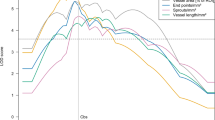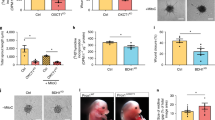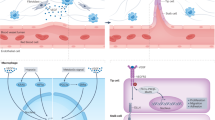Abstract
Disruption of the precise balance of positive and negative molecular regulators of blood and lymphatic vessel growth can lead to myriad diseases. Although dozens of natural inhibitors of hemangiogenesis have been identified, an endogenous selective inhibitor of lymphatic vessel growth has not to our knowledge been previously described. We report the existence of a splice variant of the gene encoding vascular endothelial growth factor receptor-2 (Vegfr-2) that encodes a secreted form of the protein, designated soluble Vegfr-2 (sVegfr-2), that inhibits developmental and reparative lymphangiogenesis by blocking Vegf-c function. Tissue-specific loss of sVegfr-2 in mice induced, at birth, spontaneous lymphatic invasion of the normally alymphatic cornea and hyperplasia of skin lymphatics without affecting blood vasculature. Administration of sVegfr-2 inhibited lymphangiogenesis but not hemangiogenesis induced by corneal suture injury or transplantation, enhanced corneal allograft survival and suppressed lymphangioma cellular proliferation. Naturally occurring sVegfr-2 thus acts as a molecular uncoupler of blood and lymphatic vessels; modulation of sVegfr-2 might have therapeutic effects in treating lymphatic vascular malformations, transplantation rejection and, potentially, tumor lymphangiogenesis and lymphedema (pages 993–994)
This is a preview of subscription content, access via your institution
Access options
Subscribe to this journal
Receive 12 print issues and online access
$209.00 per year
only $17.42 per issue
Buy this article
- Purchase on Springer Link
- Instant access to full article PDF
Prices may be subject to local taxes which are calculated during checkout






Similar content being viewed by others
References
Ferrara, N. & Kerbel, R.S. Angiogenesis as a therapeutic target. Nature 438, 967–974 (2005).
Carmeliet, P. Angiogenesis in life, disease and medicine. Nature 438, 932–936 (2005).
Fenwick, A. Waterborne infectious diseases—could they be consigned to history? Science 313, 1077–1081 (2006).
Carmeliet, P. et al. Abnormal blood vessel development and lethality in embryos lacking a single Vegf allele. Nature 380, 435–439 (1996).
Ferrara, N. et al. Heterozygous embryonic lethality induced by targeted inactivation of the Vegf gene. Nature 380, 439–442 (1996).
Karkkainen, M.J. et al. Vascular endothelial growth factor C is required for sprouting of the first lymphatic vessels from embryonic veins. Nat. Immunol. 5, 74–80 (2004).
Folkman, J. Angiogenesis in cancer, vascular, rheumatoid and other disease. Nat. Med. 1, 27–31 (1995).
Kendall, R.L. & Thomas, K.A. Inhibition of vascular endothelial cell growth factor activity by an endogenously encoded soluble receptor. Proc. Natl. Acad. Sci. USA 90, 10705–10709 (1993).
Sela, S. et al. A novel human-specific soluble vascular endothelial growth factor receptor 1: cell-type–specific splicing and implications to vascular endothelial growth factor homeostasis and preeclampsia. Circ. Res. 102, 1566–1574 (2008).
Rajakumar, A. et al. Novel soluble Flt-1 isoforms in plasma and cultured placental explants from normotensive pregnant and preeclamptic women. Placenta 30, 25–34 (2009).
Ambati, B.K. et al. Corneal avascularity is due to soluble Vegf receptor-1. Nature 443, 993–997 (2006).
Huang, X., Gottstein, C., Brekken, R.A. & Thorpe, P.E. Expression of soluble Vegf receptor 2 and characterization of its binding by surface plasmon resonance. Biochem. Biophys. Res. Commun. 252, 643–648 (1998).
Jeltsch, M. et al. Hyperplasia of lymphatic vessels in VEGF-C transgenic mice. Science 276, 1423–1425 (1997).
Joukov, V. et al. A novel vascular endothelial growth factor, VEGF-C, is a ligand for the Flt4 (VEGFR-3) and KDR (VEGFR-2) receptor tyrosine kinases. EMBO J. 15, 290–298 (1996).
Shalaby, F. et al. Failure of blood-island formation and vasculogenesis in Flk-1–deficient mice. Nature 376, 62–66 (1995).
Ashery-Padan, R., Marquardt, T., Zhou, X. & Gruss, P. Pax6 activity in the lens primordium is required for lens formation and for correct placement of a single retina in the eye. Genes Dev. 14, 2701–2711 (2000).
Maruyama, K. et al. Inflammation-induced lymphangiogenesis in the cornea arises from CD11b-positive macrophages. J. Clin. Invest. 115, 2363–2372 (2005).
Jeltsch, M. et al. Vascular endothelial growth factor (Vegf)/VEGF-C mosaic molecules reveal specificity determinants and feature novel receptor binding patterns. J. Biol. Chem. 281, 12187–12195 (2006).
Baldwin, M.E. et al. The specificity of receptor binding by vascular endothelial growth factor-d is different in mouse and man. J. Biol. Chem. 276, 19166–19171 (2001).
Streilein, J.W., Bradley, D., Sano, Y. & Sonoda, Y. Immunosuppressive properties of tissues obtained from eyes with experimentally manipulated corneas. Invest. Ophthalmol. Vis. Sci. 37, 413–424 (1996).
Kirkin, V. et al. Characterization of indolinones which preferentially inhibit VEGF-C– and VEGF-D–induced activation of VEGFR-3 rather than VEGFR-2. Eur. J. Biochem. 268, 5530–5540 (2001).
Cursiefen, C., Chen, L., Dana, M.R. & Streilein, J.W. Corneal lymphangiogenesis: evidence, mechanisms and implications for corneal transplant immunology. Cornea 22, 273–281 (2003).
Liu, Y., Hamrah, P., Zhang, Q., Taylor, A.W. & Dana, M.R. Draining lymph nodes of corneal transplant hosts exhibit evidence for donor major histocompatibility complex (MHC) class II–positive dendritic cells derived from MHC class II–negative grafts. J. Exp. Med. 195, 259–268 (2002).
Yamagami, S. & Dana, M.R. The critical role of lymph nodes in corneal alloimmunization and graft rejection. Invest. Ophthalmol. Vis. Sci. 42, 1293–1298 (2001).
Chen, L. et al. Vascular endothelial growth factor receptor-3 mediates induction of corneal alloimmunity. Nat. Med. 10, 813–815 (2004).
Yoon, Y.S. et al. VEGF-C gene therapy augments postnatal lymphangiogenesis and ameliorates secondary lymphedema. J. Clin. Invest. 111, 717–725 (2003).
Mäkinen, T. et al. Inhibition of lymphangiogenesis with resulting lymphedema in transgenic mice expressing soluble Vegf receptor-3. Nat. Med. 7, 199–205 (2001).
Karpanen, T. et al. Lymphangiogenic growth factor responsiveness is modulated by postnatal lymphatic vessel maturation. Am. J. Pathol. 169, 708–718 (2006).
Cao, Y. et al. Vascular endothelial growth factor C induces angiogenesis in vivo. Proc. Natl. Acad. Sci. USA 95, 14389–14394 (1998).
Kubo, H. et al. Blockade of vascular endothelial growth factor receptor-3 signaling inhibits fibroblast growth factor-2–induced lymphangiogenesis in mouse cornea. Proc. Natl. Acad. Sci. USA 99, 8868–8873 (2002).
Cao, R. et al. Comparative evaluation of FGF-2–, VEGF-A– and VEGF-Cinduced angiogenesis, lymphangiogenesis, vascular fenestrations and permeability. Circ. Res. 94, 664–670 (2004).
Cursiefen, C. et al. VEGF-A stimulates lymphangiogenesis and hemangiogenesis in inflammatory neovascularization via macrophage recruitment. J. Clin. Invest. 113, 1040–1050 (2004).
Cursiefen, C. et al. Lymphatic vessels in vascularized human corneas: immunohistochemical investigation using LYVE-1 and podoplanin. Invest. Ophthalmol. Vis. Sci. 43, 2127–2135 (2002).
Hamrah, P. et al. Expression of vascular endothelial growth factor receptor-3 (VEGFR-3) on monocytic bone marrow–derived cells in the conjunctiva. Exp. Eye Res. 79, 553–561 (2004).
Joukov, V. et al. Proteolytic processing regulates receptor specificity and activity of VEGF-C. EMBO J. 16, 3898–3911 (1997).
Bernatchez, P.N., Rollin, S., Soker, S. & Sirois, M.G. Relative effects of VEGF-A and VEGF-C on endothelial cell proliferation, migration and PAF synthesis: role of neuropilin-1. J. Cell. Biochem. 85, 629–639 (2002).
Roeckl, W. et al. Differential binding characteristics and cellular inhibition by soluble Vegf receptors 1 and 2. Exp. Cell Res. 241, 161–170 (1998).
Fuh, G., Li, B., Crowley, C., Cunningham, B. & Wells, J.A. Requirements for binding and signaling of the kinase domain receptor for vascular endothelial growth factor. J. Biol. Chem. 273, 11197–11204 (1998).
Wiesmann, C. et al. Crystal structure at 1.7 A resolution of Vegf in complex with domain 2 of the Flt-1 receptor. Cell 91, 695–704 (1997).
Goldman, J., Le, T.X., Skobe, M. & Swartz, M.A. Overexpression of VEGF-C causes transient lymphatic hyperplasia but not increased lymphangiogenesis in regenerating skin. Circ. Res. 96, 1193–1199 (2005).
Vasioukhin, V., Degenstein, L., Wise, B. & Fuchs, E. The magical touch: genome targeting in epidermal stem cells induced by tamoxifen application to mouse skin. Proc. Natl. Acad. Sci. USA 96, 8551–8556 (1999).
Ebos, J.M. et al. A naturally occurring soluble form of vascular endothelial growth factor receptor 2 detected in mouse and human plasma. Mol. Cancer Res. 2, 315–326 (2004).
Ebos, J.M. et al. Vascular endothelial growth factor–mediated decrease in plasma soluble vascular endothelial growth factor receptor-2 levels as a surrogate biomarker for tumor growth. Cancer Res. 68, 521–529 (2008).
Ebos, J.M., Lee, C.R., Christensen, J.G., Mutsaers, A.J. & Kerbel, R.S. Multiple circulating proangiogenic factors induced by sunitinib malate are tumor-independent and correlate with antitumor efficacy. Proc. Natl. Acad. Sci. USA 104, 17069–17074 (2007).
Kaipainen, A. et al. Expression of the fms-like tyrosine kinase 4 gene becomes restricted to lymphatic endothelium during development. Proc. Natl. Acad. Sci. USA 92, 3566–3570 (1995).
Huang, H.Y., Ho, C.C., Huang, P.H. & Hsu, S.M. Co-expression of VEGF-C and its receptors, VEGFR-2 and VEGFR-3, in endothelial cells of lymphangioma. Implication in autocrine or paracrine regulation of lymphangioma. Lab. Invest. 81, 1729–1734 (2001).
Norgall, S. et al. Elevated expression of VEGFR-3 in lymphatic endothelial cells from lymphangiomas. BMC Cancer 7, 105 (2007).
Wilting, J. et al. Embryonic development and malformation of lymphatic vessels. Novartis Found. Symp. 283, 220–227; discussion 227–229, 238–241 (2007).
Azar, D.T. Corneal angiogenic privilege: angiogenic and antiangiogenic factors in corneal avascularity, vasculogenesis, and wound healing (an American Ophthalmological Society thesis). Trans. Am. Ophthalmol. Soc. 104, 264–302 (2006).
Kerjaschki, D. et al. Lymphatic endothelial progenitor cells contribute to de novo lymphangiogenesis in human renal transplants. Nat. Med. 12, 230–234 (2006).
Brideau, G. et al. Endostatin overexpression inhibits lymphangiogenesis and lymph node metastasis in mice. Cancer Res. 67, 11528–11535 (2007).
Kojima, T., Azar, D.T. & Chang, J.H. Neostatin-7 regulates bFGF-induced corneal lymphangiogenesis. FEBS Lett. 582, 2515–2520 (2008).
Bielenberg, D.R. et al. Semaphorin 3F, a chemorepulsant for endothelial cells, induces a poorly vascularized, encapsulated, nonmetastatic tumor phenotype. J. Clin. Invest. 114, 1260–1271 (2004).
Oka, M. et al. Inhibition of endogenous TGF-beta signaling enhances lymphangiogenesis. Blood 111, 4571–4579 (2008).
Skobe, M. et al. Induction of tumor lymphangiogenesis by VEGF-C promotes breast cancer metastasis. Nat. Med. 7, 192–198 (2001).
Mandriota, S.J. et al. Vascular endothelial growth factor-C–mediated lymphangiogenesis promotes tumour metastasis. EMBO J. 20, 672–682 (2001).
Brakenhielm, E. et al. Modulating metastasis by a lymphangiogenic switch in prostate cancer. Int. J. Cancer 121, 2153–2161 (2007).
He, Y. et al. Suppression of tumor lymphangiogenesis and lymph node metastasis by blocking vascular endothelial growth factor receptor 3 signaling. J. Natl. Cancer Inst. 94, 819–825 (2002).
Hirakawa, S. et al. VEGF-C–induced lymphangiogenesis in sentinel lymph nodes promotes tumor metastasis to distant sites. Blood 109, 1010–1017 (2007).
Ando, T. et al. Isolation and characterization of a novel mouse lymphatic endothelial cell line: SV-LEC. Lymphat. Res. Biol. 3, 105–115 (2005).
Acknowledgements
We thank R. Ashery-Padan (Tel Aviv University), P. Gruss (Max Planck Institute) and D.C. Beebe (Washington University) for LeCre mice, R.K. Nordeen (University of Colorado) for Cre plasmid, K. Miyazono (University of Tokyo) for pVegf-c and J.L. Arbiser (Emory University) and C.D. Kontos (Duke University) for endothelial cell lines; R. King, L. Xu, M. McConnell, K. Emerson, A. Blanford, M. Baker, S. Furlow, M. LaFalce and C. Long for technical assistance; and R. Mohan, F. Cambi, S. Bondada, M. Detmar, M.W. Fannon, T.V. Getchell, R.K. Jain, T.S. Khurana, B.J. Raisler, J.E. Springer, P.A. Pearson, C.W. Vander Kooi, J.G. Woodward, A.M. Rao, G.S. Rao, K. Ambati and L. Garcia for valuable discussions. This work was supported by US National Institutes of Health and National Eye Institute grants EY015422, EY018350 and EY018836 to J.A. and EY017182 and EY017950 to B.K.A.; a Research to Prevent Blindness Lew R. Wassermann Merit Award (J.A.); Physician Scientist Awards (J.A., B.K.A.); a Medical Student Fellowship (R.J.C.A.); a departmental unrestricted grant (J.A.); a University of Kentucky University Research Professorship (J.A.); Fight for Sight (R.J.C.A.); Japan Society for the Promotion of Science for Young Scientists (A.T.); a VA Merit Award (B.K.A.); and the US Department of Defense (B.K.A.). J.A. is also supported by the Doris Duke Distinguished Clinical Scientist Award and the Burroughs Wellcome Fund Clinical Scientist Award in Translational Research and is the Dr. E. Vernon Smith and Eloise C. Smith Macular Degeneration Endowed Chair.
Author information
Authors and Affiliations
Contributions
R.J.C.A., T.H., W.G.C., M.E.K., S.D., A.T., J.Z.B., K.Y., H.K., M.G.G. and S.C. designed and conducted experiments. R.A.B., J.W., H.A.W. and J.S.A. provided reagents and, with J.C., S.Y., S.A., N.M., M.L.P., M.H., T.U. and B.K.A., participated in planning experiments. J.A. conceived of and directed the project. R.J.C.A. and J.A. wrote the manuscript. All authors had the opportunity to discuss the results and comment on the manuscript.
Corresponding author
Ethics declarations
Competing interests
J.A. and R.J.C.A. are named as inventors in a patent application to the US Patent and Trademark Office filed by the University of Kentucky surrounding the intellectual property described in this paper (gene and protein sequences and therapeutic application of augmenting or diminishing soluble vascular endothelial growth factor receptor-2 amounts). As employees of the University of Kentucky, they are covered under the distribution of royalties policies of the institution.
Supplementary information
Supplementary Text and Figures
Supplementary Figures 1-13 and Supplementary Methods (PDF 1391 kb)
Rights and permissions
About this article
Cite this article
Albuquerque, R., Hayashi, T., Cho, W. et al. Alternatively spliced vascular endothelial growth factor receptor-2 is an essential endogenous inhibitor of lymphatic vessel growth. Nat Med 15, 1023–1030 (2009). https://doi.org/10.1038/nm.2018
Received:
Accepted:
Published:
Issue Date:
DOI: https://doi.org/10.1038/nm.2018
This article is cited by
-
UV light-mediated corneal crosslinking as (lymph)angioregressive pretreatment to promote graft survival after subsequent high-risk corneal transplantation (CrossCornealVision): protocol for a multicenter, randomized controlled trial
Trials (2024)
-
The lymphatic vascular system: much more than just a sewer
Cell & Bioscience (2022)
-
Cystathionine β-synthase as novel endogenous regulator of lymphangiogenesis via modulating VEGF receptor 2 and 3
Communications Biology (2022)
-
PEDF inhibits lymphatic metastasis of nasopharyngeal carcinoma as a new lymphangiogenesis inhibitor
Cell Death & Disease (2021)
-
Association between ABO and Duffy blood types and circulating chemokines and cytokines
Genes & Immunity (2021)



